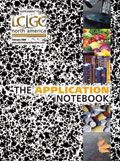TSK-GEL Amide-80 HILIC Columns for Analyzing Melamine and Cyanuric Acid in Milk by LC–MS-MS
The Application Notebook
Melamine is an organic base and a trimer of cyanamide, with a 1,3,5-triazine skeleton. Melamine can react with formaldehyde to produce melamine resin, a very durable thermosetting plastic, and melamine foam, a polymeric cleaning product. Some end products made from melamine include countertops, dry erase boards, fabrics, glues, housewares, and flame retardants. Melamine is also one of the major components in Pigment Yellow 150, a colorant in inks and plastics.
Melamine is an organic base and a trimer of cyanamide, with a 1,3,5-triazine skeleton. Melamine can react with formaldehyde to produce melamine resin, a very durable thermosetting plastic, and melamine foam, a polymeric cleaning product. Some end products made from melamine include countertops, dry erase boards, fabrics, glues, housewares, and flame retardants. Melamine is also one of the major components in Pigment Yellow 150, a colorant in inks and plastics.
In 2007 a pet food recall was initiated by Menu Foods and other pet food manufacturers when veterinary scientists in the US determined melamine to be the cause of hundreds of pet deaths, because of pet food contamination. Prior to these reports, melamine had been regarded as non-toxic or minimally toxic. Wheat gluten, a common ingredient in pet food, was found to contain residues of melamine and a related compound, cyanuric acid. Widespread pet illness and death was subsequently attributed to the formation of melamine-cyanurate crystals in the kidneys of these animals.
In September 2008, several companies in China were implicated in a scandal involving milk and infant formula which had been adulterated with melamine, leading to kidney stones and other renal failure, especially among young children. By September 22nd, nearly 53,000 people had become ill, with more than 12,800 hospitalizations and four infant deaths. Indications are that companies producing milk in China added melamine to mask the loss in nitrogen content from dilution of milk products.
On September 26, 2008, the FDA issued a statement saying that it had "broadened its domestic and import sampling and testing of milk-derived ingredients and finished food products containing milk, such as candies, desserts, and beverages that could contain these ingredients from Chinese sources. Milk-derived ingredients include whole milk powder, non-fat milk powder, whey powder, lactose powder, and casein." (http://www.fda.gov/bbs/topics/NEWS/2008/NEW01891.html)
To aid chemists charged with the determination of melamine and related products in milk, Tosoh scientists developed a method for the simultaneous determination of melamine and cyanuric acid by HILIC-MS-MS using a three micron TSKgel Amide-80 column. Milk was spiked with melamine and cyanuric acid standards to serve as a model sample.

Figure 1: Structural formulas of melamine and cyanuric acid
The structural formulas for melamine and cyanuric acid are shown in Figure 1, while Figure 2 details the pretreatment of milk samples prior to the addition of the standards.

Figure 2: Pretreatment of milk.
Results
Both melamine and cyanuric acid were determined with high recovery (data not shown). Pretreatment of the milk samples was achieved by simple deproteination with acetonitrile, as shown in Figure 3. Good linearity was obtained for both compounds for the range of 0.5 to 50ppb. .

Figure 3: Separation of melamine and cyanuric acid in milk
Multiple Reaction Monitoring is a mode of MS-MS that yields maximum sensitivity and selectivity for known target analytes. Figure 4 shows the results of this type of mass analysis on unspiked and spiked milk samples. The figure demonstrates that the original milk sample did not contain any amount of either melamine or cyanuric acid. After adding the compounds to the milk sample, melamine and cyanuric acid were independently detected, with more than sufficient resolution between the compounds. Although not shown here, analysis time was reduced to 2 min by using a shorter TSKgel Amide-80 column (3 μm, 2 mm ID × 5 cm).

Figure 4: Multiple Reaction Monitoring (MRM) chromatograms of milk and spiked milk samples - 10ppb each
Conclusion
It has been demonstrated that a TSKgel Amide-80 column can simultaneously separate melamine and cyanuric acid in milk with high recovery and excellent resolution. This is a noteworthy application since adding melamine, to mask the loss of nitrogen when diluting milk products, has resulted in serious health effects and even deaths.

Tosoh Bioscience LLC
156 Keystone Drive, Montgomeryville, PA 18936
tel. (215)283-5000, (800)366-4875, fax (215)283-5035
Website: www.tosohbioscience.com
















